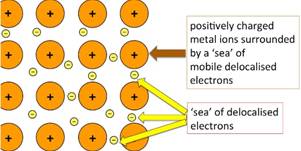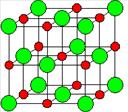
Interpretation: The contrast between the structure of ionic compounds and metals.
Concept introduction:
The packing of molecules or atoms is usually at its lattice through networks wherein there is an interaction between the molecules. Based on the strength of interaction, the bonds are further classified as ionic, hydrogen bonding, metallic bonding and covalent bonding.
Answer to Problem 40SSC
The main difference in structure is that metals are having metal ions immersed in a sea of electrons, whereas ionic compounds are those having positive and negative charges occupying lattices
Explanation of Solution
The bonding in metals is formed when the electrons in the metal leave its outer shell to form a positively charged ion. These ions are then amidst a ‘sea’ of delocalized electrons. The structure is such that metals consist of metals ions arranged at lattice points in a regular pattern.

The bonding in ionic compounds is merely electrostatic forces of attraction between the positively charged ion and negatively charged ion. The metal atom will lose electron(s) to form a positive ion while a nonmetal atom will gain electron(s) to form a negative ion. Both are held by coulombic forces to give a brittle structure.

The oppositely charged ions are next to each other forming a regular pattern.
Difference in structure
| Metals | Ionic compounds |
| The positively charged ions occupy lattice points which are surrounded by a ‘sea’ of electrons. | The positively charged ions are situated next to negatively charged ion and are arranged in a regular pattern. |
| The electrons are ‘delocalized’ over the entire lattice and are free to move about. | The electrons are not delocalized and there are no free electrons. |
| The forces of attraction are electrostatic forces between a metal ion and delocalized electrons. | The forces of attraction are electrostatic forces between two oppositely charged ions. |
The main difference in structure is that metals are having metal ions immersed in a sea of electrons whereas ionic compounds are those having positive and negative charges occupying lattices.
Chapter 7 Solutions
Chemistry: Matter and Change
Additional Science Textbook Solutions
Essential Organic Chemistry (3rd Edition)
Introductory Chemistry (5th Edition) (Standalone Book)
Chemistry: A Molecular Approach
Organic Chemistry (8th Edition)
General, Organic, and Biological Chemistry (3rd Edition)
Chemistry: The Central Science (14th Edition)
 ChemistryChemistryISBN:9781305957404Author:Steven S. Zumdahl, Susan A. Zumdahl, Donald J. DeCostePublisher:Cengage Learning
ChemistryChemistryISBN:9781305957404Author:Steven S. Zumdahl, Susan A. Zumdahl, Donald J. DeCostePublisher:Cengage Learning ChemistryChemistryISBN:9781259911156Author:Raymond Chang Dr., Jason Overby ProfessorPublisher:McGraw-Hill Education
ChemistryChemistryISBN:9781259911156Author:Raymond Chang Dr., Jason Overby ProfessorPublisher:McGraw-Hill Education Principles of Instrumental AnalysisChemistryISBN:9781305577213Author:Douglas A. Skoog, F. James Holler, Stanley R. CrouchPublisher:Cengage Learning
Principles of Instrumental AnalysisChemistryISBN:9781305577213Author:Douglas A. Skoog, F. James Holler, Stanley R. CrouchPublisher:Cengage Learning Organic ChemistryChemistryISBN:9780078021558Author:Janice Gorzynski Smith Dr.Publisher:McGraw-Hill Education
Organic ChemistryChemistryISBN:9780078021558Author:Janice Gorzynski Smith Dr.Publisher:McGraw-Hill Education Chemistry: Principles and ReactionsChemistryISBN:9781305079373Author:William L. Masterton, Cecile N. HurleyPublisher:Cengage Learning
Chemistry: Principles and ReactionsChemistryISBN:9781305079373Author:William L. Masterton, Cecile N. HurleyPublisher:Cengage Learning Elementary Principles of Chemical Processes, Bind...ChemistryISBN:9781118431221Author:Richard M. Felder, Ronald W. Rousseau, Lisa G. BullardPublisher:WILEY
Elementary Principles of Chemical Processes, Bind...ChemistryISBN:9781118431221Author:Richard M. Felder, Ronald W. Rousseau, Lisa G. BullardPublisher:WILEY





